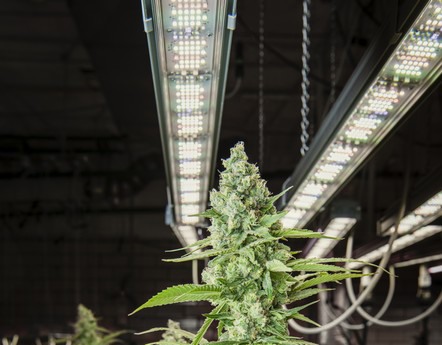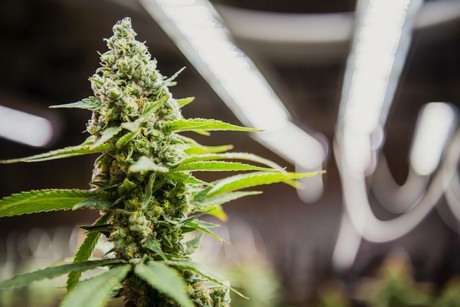There are different aspects to take into consideration when growing medicinal-grade cannabis. One of the most important things that affects the plant growth is light, which can be differentiated in light quality, light intensity and photoperiod. According to research conducted by the CREA institute, “it is possible to manipulate the morphology of the cannabis plant through specific light spectrum combinations.” The research continues explaining that HPS lights grant a plant “longer internodes and therefore taller plants with more stem dry weight.” However, plants treated with LED lights had a higher cannabinoid content, “enhancing the compact growth habit of the measured plants.” In conclusion, cannabis plants grow healthier with a higher concentration of THC and CBD under LED lights than under HPS lights. This is the key difference: spectrum quality and light intensity.
Valoya is a lighting company producing wide spectra LED light solutions, and its mission is exactly to “teach the importance of the spectrum with regards to everything occurring within the plants in terms of photobiology,” Donato Lucia, account manager with Valoya, explains. “The real challenge is that only a few can understand the quality of a LED spectrum. Not all LED lights are the same.”
The eternal question
To the eternal question of HPS vs LED, Donato firmly replies: “HPS is an obsolete technology which is destined to disappear. The European community has already banned incandescent lamps – they are extremely costly energy-wise.”

Valoya has been developing advanced LED solutions finding the perfect balance between different parameters. “We invest a substantial amount of money in research and development exactly because we want to empower growers and allow them to grow the highest quality cannabis with consistency,” Donato points out. “The cannabis plant is a living organism and it needs the complete sunlight spectrum. That is why we developed wide-spectra LED light solutions.”
Red and Blue
Donato continues explaining the difference between a wide spectra LED light and a red and blue LED light. “Giving a cannabis plant only red and blue lights is equal to feeding a child with just proteins and fat. Instead, they need way more than that, and then it is up to the organism to take what is better for it. This is the same concept behind the wide-spectra LED lights. In developing those we replicate the quality of sunlight and then optimize it by removing the wavelengths which do not contribute to plant development and thus end up with an energy efficient lamp. For instance, Valoya’s spectra are the widest on the market, spanning the range from UV-A until far red. The balanced amount of UV-A provides a healthy amount of stress for the plant that the Sun provides in the nature. As a response the plant produces valuable cannabinoids and terpenoids that the growers are after. Most of the plants grown indoor suffer from a sunlight deficiency, which is not the mere lack of light, but it is in fact the lack of different wavelengths from the spectrum to stimulate all of plants photoreceptors, including those that respond to shorter wavelengths only.”
Argentinian pampa in Berlin
Aside from the wide-spectra solution, Valoya developed LightDNA®, which is “the most sophisticated application of the LED technology in horticulture, the main purpose of which is research,” Donato states. “Our LightDNA® can replicate spectra from all over the world with a click of a button in the online interface through which the lamps are controlled. For instance, it is possible to recreate the conditions of the Argentinian pampa in a growth chamber in Berlin, thus understanding how different crops react to it.”

High quality achievable only indoor
Growing cannabis for the pharmaceutical industry is different than growing it for the recreational market. The regulations in effect leave little to no room for mistake, and this is exactly why Donato remarks that consistent high quality can be achieved only within indoor environments. “Quality consistency is one of the prerequisites to obtaining the GMP certification – growers need to demonstrate they are able to do it,” Donato explains. “This is possible only indoor, where all the parameters are under control and adapted to this or that situation. By replicating the wide spectrum that plants need, it is possible to regulate the light intensity according to the photoperiod. This kind of control is achievable only indoor. In greenhouses this is a goal which is extremely difficult to reach, as they are at the mercy of the external climate.”
A slow but steady change
Thus, according to Donato, LED lights are better than HPS. However, part of the industry is still using HPS lights. “This is because HPS lights have been used for a very long time. Therefore, all the benchmarks have been made using HPS. However, as we have seen, LED lights afford a better and wider spectrum which enable the plant to grow healthier and of higher quality. There is a wrong perception that LED costs more than HPS. A calculation of operating lifetime of both technologies shows that savings are made with LED. On top of that, good LED will ensure bringing a superior cannabis product to the market, placing the grower at the front of the pack. As mentioned already, not all LED is the same and we advise growers to exercise caution and demand their lighting supplier to back up their claims with scientific data, references etc.”
For more information:
Valoya Oy
Melkonkatu 26, 2nd floor
00210 Helsinki, Finland
+358 10 2350 300
valoya.com
